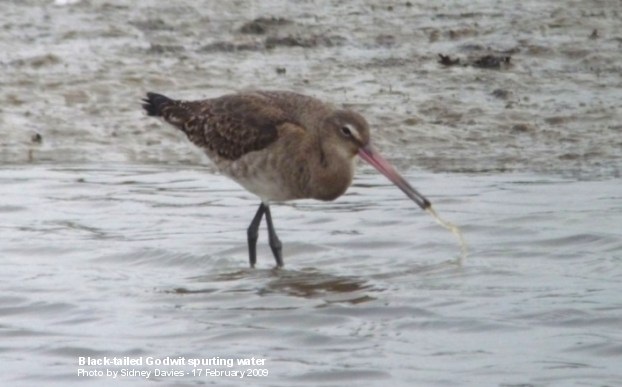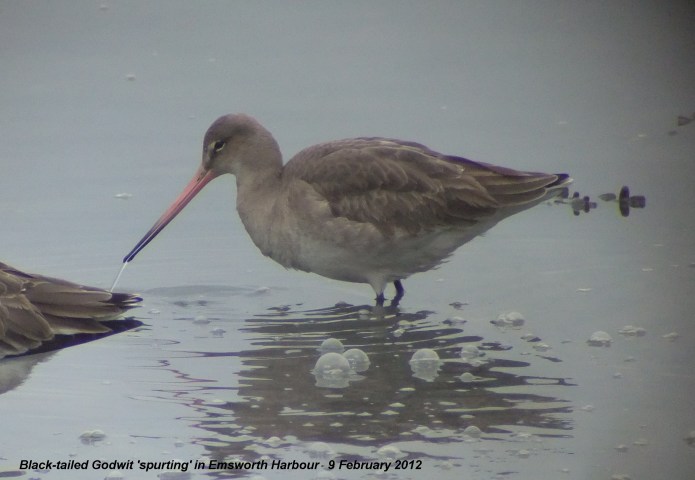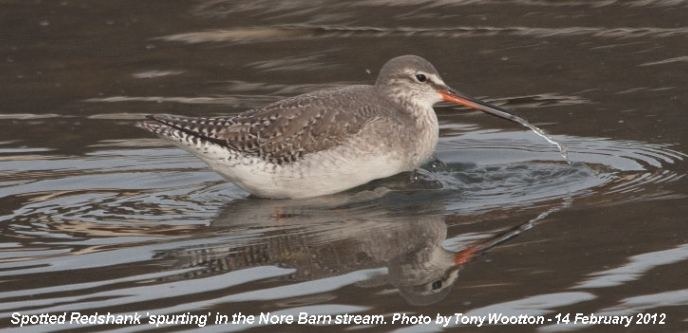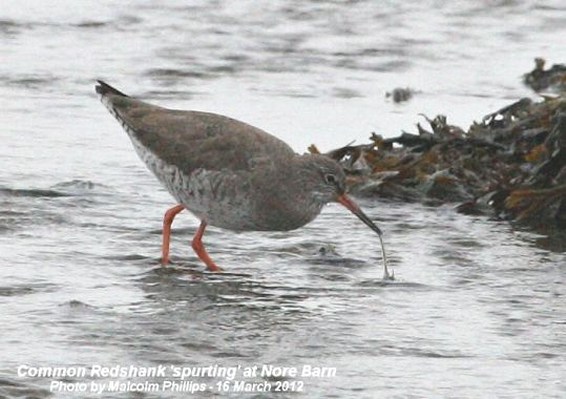RETURN TO . . . Emsworth Wildlife Homepage
RETURN TO . . . Spurting behaviour
See also . . .Black-tailed Godwits. . . Godwit current news with links to colour ringing and to 'spurting' behaviour
Spurting behaviour in wading birds
by Brian Fellows, EmsworthPaper published in the Wader Study Group Bulletin Vol 120 (3) 2013 208-209
Keywords: Black-tailed Godwit, Limosa limosa ssp islandica, Emsworth Harbour, England, wading birds, feeding, spurting water.
Many wading birds, including up to 150 Black-tailed Godwits Limosa limosa ssp. islandica, feed regularly in winter in Emsworth Harbour (50°50’N, 0°57’W), part of the Chichester Harbour complex, a large tidal harbour on the south coast of England. Emsworth is my home town and I have been watching the godwits there for many years, counting and logging the colour-ringed birds and taking photos.
Looking through my photos, and those of other local birdwatchers, it appeared that, on occasions, the godwits would spurt water from their bills when feeding in shallow water (Figs. 1 & 2, overleaf). It was also apparent that this behaviour was not restricted to Black-tailed Godwits, as it was also recorded in other wading birds, including Spotted Redshank Tringa erythropus, Common Redshank T. totanus, Greenshank T. nebularia and Eurasian Spoonbill Platalea leucorodia (Figs. 3, 4 & 5). This suggested that ‘spurting’ may be a general characteristic of wading birds feeding in shallow water and not confined to Black-tailed Godwits.
Several wader experts have been shown the photographs, but none have recognised the behaviour as something they have seen themselves or been able to explain. In my experience the behaviour is relatively common. Therefore it is surprising that the expulsion of water by waders during feeding has not previously been acknowledged.
I describe spurting behaviour as follows: the bird dips its bill into the water for a couple of seconds, or sometimes a bit longer, presumably to obtain food. It then withdraws its bill and slightly pushes its head forward, usually (though not always) with the bill lowered and then ejects or spurts a stream of water, as if ridding itself of surplus liquid taken in while feeding underwater. The bill is then reinserted in the water and the sequence is repeated.
All this happens very quickly and is not easily seen with the naked eye, though the behaviour shows up well in photographs, such as those presented here. More reports of this behaviour with photographs can be seen on my special ‘spurting’ web page (www.emsworthwildlife.hampshire.org.uk/x-black-tailed-godwit-spurting.htm). I have also put a short digiscoped video of some Black-tailed Godwits feeding near the shore at Nore Barn, Emsworth, in January 2012 on YouTube showing examples of spurting (http://youtu.be/uHXSH9jzh94). The only other published photograph of spurting I have come across for the United Kingdom is by Matt Thomas (2011) who has two images of Black-tailed Godwits in August 2011 ejecting what appears to be muddy water and pieces of worms. There is also a photograph on PBase.com (2007) showing a Hudsonian Godwit L. haemastica seemingly doing the same thing.
Although my observations lead me to the opinion that water is forcibly ejected, I do not discount the possibility that water drains more passively from the bill and is thrown out by the action of the bird in raising its bill from the water. Thus, the bird feeds below the surface of the water for a few seconds, then lifts its head quickly throwing out the excess water from its bill as it does so. A good-quality video, suitably slowed down, would probably show just what was going on more clearly. My explanation for spurting behaviour is that water, and other material inadvertently taken in along with prey during feeding, needs to be expelled by the bird before it can continue feeding. It is clear from the photographs that a good quantity of water is ejected. Sometimes, small objects can be seen in the stream of water (Fig. 6), but often the water coming from the bill looks clear and unsullied.
To explain why water may be forcibly ejected, Ralph Hollins (pers. comm.) has suggested that when a bird is hungry, it might try to ensure that it gets any food content out of a bill that is full of water by forcing the water out though a minimal gap between the mandibles, thus retaining tiny food items in the bill, much in the manner of filterfeeding ducks, such as Northern Shoveler Anas clypeata. A potential explanation for the evolution of spurting behaviour (either being active spurting or just the shape and design of bill that allows for the expulsion of water and unwanted items) could be that birds foraging in saline waters, and already having to deal with salinity on their prey, would need to excrete all other excess water (and sediment), thus reducing the saline load acquired during foraging. It is well known that dealing with salinity is costly to birds and this could be a way in which this is reduced (Gutiérrez et al. 2011, Hannam et al. 2003, Peaker & Linzell 1975). Once this behaviour evolved to deal with foraging in saline waters, then it might also occur in freshwater habitats as the medium is similar.
I thank Sid Davies, Tony Wootton and Malcolm Phillips for allowing me to use their photographs. I am grateful to José Alves for his comments on a draft of this note.
Gutiérrez, J.S., Dietz, M.W., Masero, J.A., Gill Jr, R.E., Dekinga, A., Battley, P.F., Sánchez-Guzmán, J.M. & Piersma, T. 2012. Functional ecology of saltglands in shorebirds: flexible responses to variable environmental conditions. Functional Ecol. 26: 236–244.
Hannam, K.A., Oring, L.W. & Herzog, M.P. 2003. Impacts of salinity on growth and behaviour of American avocets chicks. Waterbirds 26: 119–125.
Peaker M. & Linzell J.L. 1975. Salt glands in birds and reptiles. Cambridge University Press, Cambridge, UK.
PBase.com2007. Shorebird feeding behaviour. www.pbase.com/mbb/prey_ transport_by_surface_tension_of_water (accessed 1 February 2014).
Thomas, M. 2011. Photos of Black-tailed Godwits feeding. 4 & 24 Aug 2011. http://deebirder.blogspot.com/2011_08_01_archive.html (accessed 1 February 2014).
Figures
Fig 1 - Black-tailed Godwit spurting. Thorney Island 17 Feb 2009. Sid Davies
Fig 2 - Close up of Black-tailed Godwit spurting. Nore Barn Emsworth Harbour. 9 February 2012. Brian Fellows
Fig 3 - Spotted Redshank spurting. Nore Barn Emsworth Harbour. 14 February 2012. Tony Wootton.
Fig 4 - Common Redshank spurting. Nore Barn Emsworth Harbour. 15 March 2012. Malcolm Phillips.
Fig 5 - Spoonbill spurting. Emsworth Harbour. 13 December 2002. Brian Fellows
Fig 6 - Black-tailed Godwit spurting objects. Nore Barn Emsworth Harbour 5 December 2012. Brian Fellows
COMMENTS OF REFEREEThis short communication describes what I believe to be a novel aspect of wader foraging behaviour. To the best of my knowledge and after consulting experts on wader foraging behaviour, "spurting" in these species has never been described. I myself have never noticed it, although I have noticed water splashes around the bill when it is pulled out of the water, and the bird makes a swallowing movement tilting the head and neck forwards. I remain unconvinced that this is an active expulsion of water (and sediment) under pressure from the bill. In my view, this is mostly water draining down the bill (both inside and outside) which together with the swallowing movement done to ingest the prey item gives the impression that water is being actively expelled under pressure. But having said this, I believe that based on observations of active birds it won't be possible to test which process is underlying the observer pattern. Therefore my recommendation is that this communication is published and perhaps then other experts can shed light on this matter. José A. Alves





